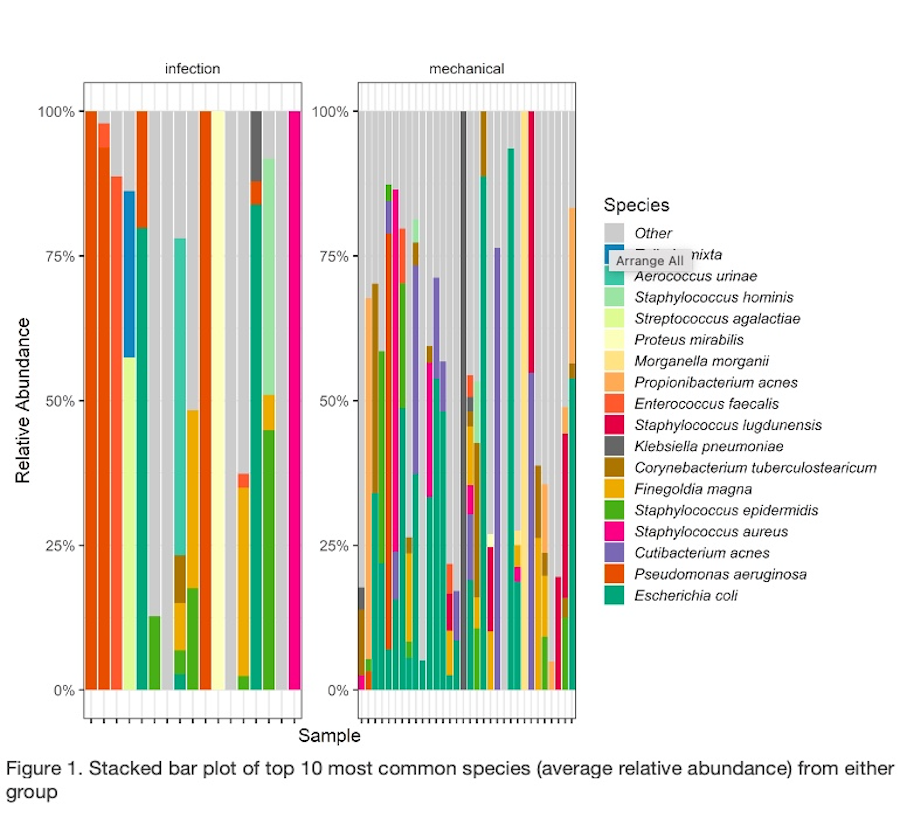Back
Introduction: We have known biofilm is present at the time of revision surgery in penile prostheses (PP) for both infectious and noninfectious etiologies with wonderment on what factors caused infections. Next-generation sequencing (NGS) compares DNA to identify isolates and report relative abundances. NGS has become the gold standard for identification of isolates in several other medical specialties. The objective of this study was to determine what makes some biofilms become clinically infected versus staying noninfectious.
Methods: 126 patients from 2 centers underwent PP surgery for infectious and non-infectious reasons. During revision surgery, a swab specimen from the pump space were collected and sent for evaluation at the institutional laboratory and for NGS testing (MicroGenDX, Lubbock, Texas, USA). Species’ relative abundances, sample richness and diversity, and compositional differences among samples were calculated and tested for group differences. The effect of sample variables on inter-sample variation in species richness (number of species detected per sample) was assessed using multiple ANOVA in which surgical indication, physician, race, and time to surgery were simultaneously included as predictors of species richness.
Results: 104 (83%) patients underwent revision surgery for non-infectious reasons with 22 (17%) for infectious reasons. The median age was 69 years with a racial breakdown was 84 White, 41 African American, and 1 unknown. Surgical indication was significant (p = 0.04) with infectious revision having less specie richness; but greater distance from Group Centroid (p = 0.03) as compared to noninfectious patients’ biofilm. The prevalence rates of species within each group were tabulated, and prevalence rates for species that were among the top 10 most frequently observed in either group are shown in Figure 1. Testing was conducted to assess significant prevalence rates in either group: P. aeruginosa was significantly over-represented in infection samples.
Conclusions: Clinically infected PP biofilm using NGS appears to have less specie richness and more compositionally distinct than biofilm from noninfectious patients’ PP. It appears Pseudomonas aeruginosa appears to be a highly likely causative agent for PP infections. SOURCE OF
Funding: MicroGenDX

Moderated Poster Session
Session: MP15: Infections/Inflammation/Cystic Disease of the Genitourinary Tract: Prostate & Genitalia
MP15-19: Determining Differences in Clinically Infected Versus Noninfectious Biofilm at the Time of Revision Surgery Using Next Generation Sequencing
Friday, April 28, 2023
1:00 PM – 3:00 PM CST
Location: S404C
- GH
Poster Presenter(s)
Introduction: We have known biofilm is present at the time of revision surgery in penile prostheses (PP) for both infectious and noninfectious etiologies with wonderment on what factors caused infections. Next-generation sequencing (NGS) compares DNA to identify isolates and report relative abundances. NGS has become the gold standard for identification of isolates in several other medical specialties. The objective of this study was to determine what makes some biofilms become clinically infected versus staying noninfectious.
Methods: 126 patients from 2 centers underwent PP surgery for infectious and non-infectious reasons. During revision surgery, a swab specimen from the pump space were collected and sent for evaluation at the institutional laboratory and for NGS testing (MicroGenDX, Lubbock, Texas, USA). Species’ relative abundances, sample richness and diversity, and compositional differences among samples were calculated and tested for group differences. The effect of sample variables on inter-sample variation in species richness (number of species detected per sample) was assessed using multiple ANOVA in which surgical indication, physician, race, and time to surgery were simultaneously included as predictors of species richness.
Results: 104 (83%) patients underwent revision surgery for non-infectious reasons with 22 (17%) for infectious reasons. The median age was 69 years with a racial breakdown was 84 White, 41 African American, and 1 unknown. Surgical indication was significant (p = 0.04) with infectious revision having less specie richness; but greater distance from Group Centroid (p = 0.03) as compared to noninfectious patients’ biofilm. The prevalence rates of species within each group were tabulated, and prevalence rates for species that were among the top 10 most frequently observed in either group are shown in Figure 1. Testing was conducted to assess significant prevalence rates in either group: P. aeruginosa was significantly over-represented in infection samples.
Conclusions: Clinically infected PP biofilm using NGS appears to have less specie richness and more compositionally distinct than biofilm from noninfectious patients’ PP. It appears Pseudomonas aeruginosa appears to be a highly likely causative agent for PP infections. SOURCE OF
Funding: MicroGenDX

